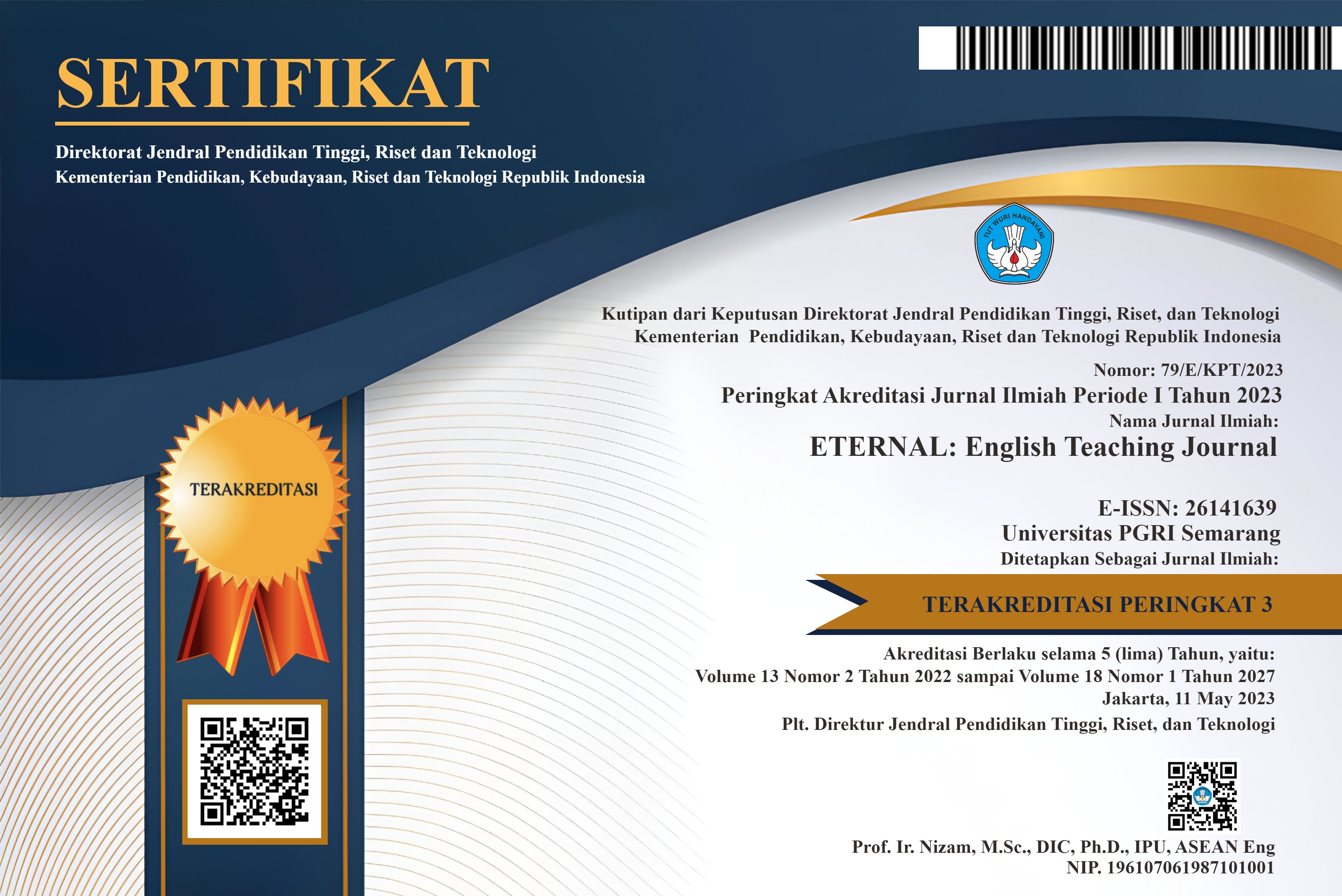Improving the English Skills by Using Microsoft Office in the Learning Process for Management Informatics Students
DOI:
https://doi.org/10.26877/eternal.v15i2.496Keywords:
Information and communication technology, Microsoft Office, Microsoft Word, Microsoft PowerPoint, EndNoteAbstract
Information and communication high technology in the world of education can be given in numerous disparate forms turn on cast their votes function. Microsoft department exists as a form of information and communication technology, big-name software that can be used in the process of learning English. The purpose of this activity is to help students better understand the features provided by Microsoft Office, including the Microsoft Word application (integrating between EndNote and Word for writing citations and references) and PowerPoint (Making a video). Deplorably, the continuous online course has brought almost various challenges within the domain of instruction, including both the substance being instructed and the guidelines instruments utilized, eventually driving decay in learning results. This emphasizes the creation of Microsoft Office-based advanced assets for instructive purposes, which are at that point included within the learning preparation. The technique utilized in this think about was investigation and advancement. The media improvement handle utilized the Four-D worldview, as proposed by Thiagarajan and Semmel. The Microsoft Office-based computerized content learning offers intuitive learning through Microsoft Office that coordinates with the ELLMA learning administration framework. A test of 25 understudies at Politeknik Mitra Karya Mandiri was subjected to testing of the media amid the Learning Proses, which yielded positive acknowledgment comes about. The discoveries of this ponder propose that utilizing Microsoft Office-based computerized data is both practical and productive in upgrading understudy inspiration and making strides in learning results. This recommends that joining computerized learning into online instruction can be useful for directing college understudies. The approach is one of education, training, and practice as well as instruction and practice for 1st semester of information management students and 1st semester of Health Analyst at the Politeknik Mitra Karya Mandiri Ketanggungan Brebes. This mentoring activity received positive feedback from the target audience.
References
Afrilyasanti, R., & Basthomi, Y. (2011). Digital Storytelling: A Case Study on the Teaching of Speaking To Indonesian EFL Students. Language in India, 11(2).
Arochman, T., & Fortinasari, P. B. (2024). Implementation of Technology-based learning by pre-service teachers during teaching practice program. Premise: Journal of English Education and Applied Linguistics, 13(1), 126–145. https://doi.org/10.24127/pj.v13i1.8988
Chun, D., Smith, B., & Kern, R. (2016). Technology in Language Use, Language Teaching, and Language Learning. Modern Language Journal, 100, 64–80. https://doi.org/10.1111/modl.12302
Delimasari, A., Fauziah, N., Anjarsari, D. P., & Arochman, T. (2023). Classroom’s environment and FOMO: students’ perspectives. IDEAS: Journal on English Language Teaching and Learning, Linguistics and Literature, 11(2), 1494–1506. https://doi.org/10.24256/ideas.v11i2.3941
Departemen Pendidikan Nasional. (2005). Undang-Undang Nomor 16 Tahun 2005, Tentang Guru dan Dosen, Jakarta: Depdiknas.
Gall, M., Gall, J., & Borg, W. (2007). Educational research: an introduction (8. utg.).
Göbel, S., de Carvalho Rodrigues, A., Mehm, F., & Steinmetz, R. (2009). Narrative game-based learning objects for story-based digital educational games. narrative, 14, 16.
Gregori-Signes, C. (2008). Integrating the old and the new: Digital storytelling in the EFL language classroom. Greta, 16(1), 43-49.
Isman, A. (2011). Instructional design in education: new model. In TOJET: The Turkish Online Journal of Educational Technology (Vol. 10). Retrieved from www.aytekinisman.com
Kajder, S. B. (2006). Bringing the outside in: Visual ways to engage reluctant readers. Stenhouse Publishers.
Kahn, H. E., & Agnew, M. (2017). Global Learning Through Difference: Considerations for Teaching, Learning, and the Internationalization of Higher Education. Journal of Studies in International Education, 21(1), 52–64. https://doi.org/10.1177/1028315315622022
Kim, S. (2014). Developing autonomous learning for oral proficiency using digital storytelling. Language Learning & Technology, 18(2), 20-35.
Lee, L. (2014). Digital news stories: Building language learners' content knowledge and speaking skills. Foreign Language Annals, 47(2), 338-356.
Lupshenyuk, D., Hocutt, M., & Owston, R. (2011). Web Video Project as an Instructional Strategy in Teacher Education. Society for Information Technology & Teacher Education International Conference 2011, 2011, 984–991. Retrieved from http://editlib.org/p/36412
Moeller, B., & Reitzes, T. (2011). Integrating Technology with Student-Centered Learning. A Report to the Nellie Mae Education Foundation. Education Development Center, Inc.
Mugara, R. (2011). Meningkatkan Kompetensi Guru Melalui Penguasaan Teknologi Informasi dan Komunikasi (TIK). Prodi Pengembangan Kurikulum. Bandung: Universitas Pendidikan Indonesia.
Pendidikan, K., & Indonesia, K. R. (2013). Implementasi kurikulum 2013. Tersedia di https://pengawasmadrasah. files. wordpress. com/2013/11/7-panduanpenilaian-kompetensi- sikap-2013. pdf (di akses 17-10-2019).
Piotrowski, J., & Reason, R. (2000). The national literacy strategy and dyslexia: A comparison of teaching methods and materials. Support for Learning, 15(2), 51-57.
Praudyani, A.V.R & Rohmadheny, P.S. (2019). Pelatihan pemanfaatan aplikasi microsoft office dalam pembelajaran sebagai upaya peningkatan profesionalisme bagi guru PAUD di PCA Mantrijeron. Seminar Nasional Hasil Pengabdian kepada Masyarakat Universitas Ahmad Dahlan.
Reese, S. A. (2015). Online learning environments in higher education: Connectivism vs. dissociation. Education and Information Technologies, 20(3), 579–588. https://doi.org/10.1007/s10639-013- 9303-7
Rodríguez Illera, J. L. & Londoño Monroy, G. (2009). Los relatos digitales y su interés educativo. Educação, Formação & Tecnologias, 2(1), 5–18.
Suryani, Siti. (2017). Pemanfaatan program Microsoft Powerpoint dan Microsoft Word dalam pembelajaran tik di SMP Negeri 30 Makassar. Jurnal Penelitian Insani, 20(2), 117-121.
Yuksel, P., Robin, B. R., & McNeil, S. (2010). Educational uses of digital storytelling around the world. In M. Koehler & P. Mishra (Eds.), Proceedings of the Society for Information Technology & Teacher Education international conference 2011 (pp. 1264-1271). Chesapeake, VA: AACE.







